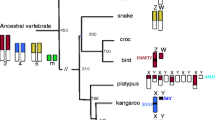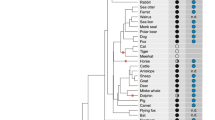Abstract
Mammalian sex chromosomes evolved from an ancient autosomal pair. Mapping of human X- and Y-borne genes in distantly related mammals and non-mammalian vertebrates has proved valuable to help deduce the evolution of this unique part of the genome. The platypus, a monotreme mammal distantly related to eutherians and marsupials, has an extraordinary sex chromosome system comprising five X and five Y chromosomes that form a translocation chain at male meiosis. The largest X chromosome (X1), which lies at one end of the chain, has considerable homology to the human X. Using comparative mapping and the emerging chicken database, we demonstrate that part of the therian X chromosome, previously thought to be conserved across all mammals, was lost from the platypus X1 to an autosome. This region included genes flanking the XIST locus, and also genes with Y-linked homologues that are important to male reproduction in therians. Since these genes lie on the X in marsupials and eutherians, and also on the homologous region of chicken chromosome 4, this represents a loss from the monotreme X rather than an additional evolutionary stratum of the human X.
Similar content being viewed by others
Author information
Authors and Affiliations
Corresponding author
Rights and permissions
About this article
Cite this article
Waters, P.D., Delbridge, M.L., Deakin, J.E. et al. Autosomal location of genes from the conserved mammalian X in the platypus (Ornithorhynchus anatinus): implications for mammalian sex chromosome evolution. Chromosome Res 13, 401–410 (2005). https://doi.org/10.1007/s10577-005-0978-5
Received:
Accepted:
Issue Date:
DOI: https://doi.org/10.1007/s10577-005-0978-5




